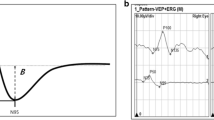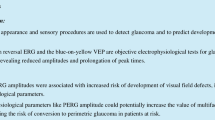Abstract
Purpose To evaluate the ability of full-field and hemifield pattern electroretinogram (PERG) parameters to differentiate between healthy eyes and eyes with band atrophy (BA) of the optic nerve. Methods Twenty-six eyes from 26 consecutive patients with permanent temporal hemianopic visual field defects and BA of the optic nerve from previous chiasmal compression and 26 healthy subjects were studied prospectively. All patients were submitted to an ophthalmic examination including Humphrey 24-2 SITA Standard automated perimetry. Full-field and hemifield (nasal and temporal) stimulation transient pattern electroretinograms (PERG) were recorded using checkerboard screens. Amplitudes and peak times for the P50 and N95 as well as the overall P50+N95 amplitude were measured. The intraocular N95:P50 amplitude ratio was calculated. Comparisons were made using Student’s t-test. Receiver operating characteristic (ROC) curves were used to describe the ability of PERG parameters to discriminate the groups. Results Full-field P50, N95, and P50+N95 amplitude values were significantly smaller in eyes with BA than in control eyes (P < 0.001). Nasal and temporal hemifield PERG studies revealed significant differences in N95 and P50+N95 amplitudes measurements. No significant difference was observed regarding peak times or N95:P50 amplitude ratios. Nasal and temporal hemifield PERG values did not differ significantly in eyes with BA or in controls. Using the 10th percentile of normals as the lower limit of normal, 16 of 26 eyes were considered abnormal according to the best discriminating parameters. Conclusions Transient PERG amplitude measurements were efficient at differentiating eyes with BA and permanent visual field defects from normal controls. Hemifield stimulation PERG parameters were unable to detect asymmetric hemifield neural loss, but further studies are required to clarify this issue.



Similar content being viewed by others
References
Holder GE, Brigell MG, Hawlina M, Meigen T, Vaegan, Bach M (2007) ISCEV standard for clinical pattern electroretinography-2007 update. Doc Ophthalmol 114:111–116
Maffei L, Fiorentini A, Bisti S, Hollander H (1985) Pattern ERG in the monkey after section of the optic nerve. Exp Brain Res 59:423–425
Hood DC, Xu L, Thienprasiddhi P, Greenstein VC, Odel JG, Grippo TM, Liebmann JM, Ritch R (2005) The pattern electroretinogram in glaucoma patients with confirmed visual field deficits. Invest Ophthalmol Vis Sci 46:2411–2418
Holder GE (1987) Significance of abnormal pattern electroretinography in anterior visual pathway dysfunction. Br J Ophthalmol 71:166–171
Viswanathan S, Frishman LJ, Robson JG (2000) The uniform field and pattern ERG in macaques with experimental glaucoma: removal of spiking activity. Invest Ophthalmol Vis Sci 41:2797–2810
Marx MS, Podos SM, Bodis-Wollner I, Howard-Williams JR, Siegel MJ, Teitelbaum CS, Maclin EL, Severin C (1986) Flash and pattern electroretinograms in normal and laser-induced glaucomatous primate eyes. Invest Ophthalmol Vis Sci 27:378–386
Marx MS, Bodis-Wollner I, Lustgarten JS, Podos SM (1987) Electrophysiological evidence that early glaucoma affects foveal vision. Doc Ophthalmol 67:281–301
Bach M, Speidel-Fiaux A (1989) Pattern electroretinogram in glaucoma and ocular hypertension. Doc Ophthalmol 73:173–181
Graham SL, Wong VA, Drance SM, Mikelberg FS (1994) Pattern electroretinograms from hemifields in normal subjects and patients with glaucoma. Invest Ophthalmol Vis Sci 35:3347–3356
Berninger TA, Heider W (1990) Pattern electroretinograms in optic neuritis during the acute stage and after remission. Graefes Arch Clin Exp Ophthalmol 228:410–414
Ruther K, Ehlich P, Philipp A, Eckstein A, Zrenner E (1998) Prognostic value of the pattern electroretinogram in cases of tumors affecting the optic pathway. Graefes Arch Clin Exp Ophthalmol 236:259–263
Parmar DN, Sofat A, Bowman R, Bartlett JR, Holder GE (2000) Visual prognostic value of the pattern electroretinogram in chiasmal compression. Br J Ophthalmol 84:1024–1026
Graham SL, Drance SM, Chauhan BC, Swindale NV, Hnik P, Mikelberg FS, Douglas GR (1996) Comparison of psychophysical and electrophysiological testing in early glaucoma. Invest Ophthalmol Vis Sci 37:2651–2662
Hood DC (2003) Objective measurement of visual function in glaucoma. Curr Opin Ophthalmol 14:78–82
Ventura LM, Porciatti V, Ishida K, Feuer WJ, Parrish RK II (2005) Pattern electroretinogram abnormality and glaucoma. Ophthalmology 112:10–19
Ventura LM, Sorokac N, De Los Santos R, Feuer WJ, Porciatti V (2006) The relationship between retinal ganglion cell function and retinal nerve fiber thickness in early glaucoma. Invest Ophthalmol Vis Sci 47:3904–3911
O’Donaghue E, Arden GB, O’Sullivan F, Falcao-Reis F, Moriarty B, Hitchings RA, Spilleers W, Hogg C, Weinstein G (1992) The pattern electroretinogram in glaucoma and ocular hypertension. Br J Ophthalmol 76:387–394
Parisi V, Miglior S, Manni G, Centofanti M, Bucci MG (2006) Clinical ability of pattern electroretinograms and visual evoked potentials in detecting visual dysfunction in ocular hypertension and glaucoma. Ophthalmology 113:216–228
Garway-Heath DF, Holder GE, Fitzke FW, Hitchings RA (2002) Relationship between electrophysiological, psychophysical, and anatomical measurements in glaucoma. Invest Ophthalmol Vis Sci 43:2213–2220
Holopigian K, Snow J, Seiple W, Siegel I (1988) Variability of the pattern electroretinogram. Doc Ophthalmol 70:103–115
Monteiro ML, Leal BC, Rosa AA, Bronstein MD (2004) Optical coherence tomography analysis of axonal loss in band atrophy of the optic nerve. Br J Ophthalmol 88:896–899
Moura FC, Medeiros FA, Monteiro ML (2007) Evaluation of macular thickness measurements for detection of band atrophy of the optic nerve using optical coherence tomography. Ophthalmology 114:175–181
DeLong EM, DeLong DM, Clarke-Pearson DL (1988) Comparing the areas under two or more correlated receiver operating characteristic curves: a nonparametric approach. Biometrics 44:837–845
Bach M, Unsoeld AS, Philippin H, Staubach F, Maier P, Walter HS, Bomer TG, Funk J (2006) Pattern ERG as an early glaucoma indicator in ocular hypertension: a long-term, prospective study. Invest Ophthalmol Vis Sci 47:4881–4887
Monteiro ML, Leal BC, Moura FC, Vessani RM, Medeiros FA (2007) Comparison of retinal nerve fibre layer measurements using optical coherence tomography versions 1 and 3 in eyes with band atrophy of the optic nerve and normal controls. Eye 21:16–22
Kerrison JB, Lynn MJ, Baer CA, Newman SA, Biousse V, Newman NJ (2000) Stages of improvement in visual fields after pituitary tumor resection. Am J Ophthalmol 130:813–820
Parisi V, Manni G, Spadaro M, Colacino G, Restuccia R, Marchi S, Bucci MG, Pierelli F (1999) Correlation between morphological and functional retinal impairment in multiple sclerosis patients. Invest Ophthalmol Vis Sci 40:2520–2527
Tobimatsu S, Celesia GC, Cone S, Gurati M (1989) Electroretinogram to checkerboard pattern reversal in cats: physiological characteristics and effect of retrograde degeneration of ganglion cells. Electroencephalogr Clin Neurophysiol 73:341–352
Bach M, Sulimma F, Gerling J (1998) Little correlation of the pattern electroretinogram (PERG) and visual field measures in early glaucoma. Doc Ophthalmol 94:253–263
Acknowledgements
This study is supported by grants from Fundação de Amparo a Pesquisa do Estado de São Paulo FAPESP (Nos 06/61549-6; 07/54142-0), São Paulo, Brazil.
Approval from the Institutional Review Board Ethics Committee was obtained for the study from “Comissão de Ética para Análise de Projetos de Pesquisa (CAPPesq)”, Hospital das Clínicas of the University of São Paulo Medical School, São Paulo, Brazil.
Author information
Authors and Affiliations
Corresponding author
Additional information
Study registered on ClinicalTrial.gov number: NCT00553761
Rights and permissions
About this article
Cite this article
Cunha, L.P., Oyamada, M.K. & Monteiro, M.L.R. Pattern electroretinograms for the detection of neural loss in patients with permanent temporal visual field defect from chiasmal compression. Doc Ophthalmol 117, 223–232 (2008). https://doi.org/10.1007/s10633-008-9126-9
Received:
Accepted:
Published:
Issue Date:
DOI: https://doi.org/10.1007/s10633-008-9126-9




